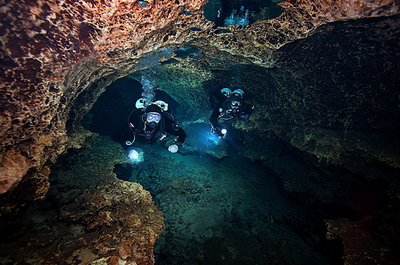Ginnie Springs
Ginnie Springs is also a full service campground, picnic area, and water sports center, offering canoeing and snorkeling in the springs and the nearby Sante Fe River.
I recommend starting with a dive into the Ginnie Spring Basin and Ballroom, dedicating a tank to it, then doing a second dive in the 3 Devil Springs, using a fresh tank, even though your first tank may not be empty. Little Devil, Devil’s Eye, and Devil’s Ear can all be done on one tank, and since they’re a quarter mile away from Ginnie Spring, it’s a good time to change over.

Described by Jacques Cousteau as the clearest water in the world, the basin of Ginnie Springs offers an excellent place to feed the dozens of fish or hone underwater photography skills. The basin is about 18′ deep at the entrance to the cavern, the main feature of this spring. To the right and below are the two entrances to the big cavern known as the Ballroom.

Bring a dive light. This is the only spring in the Ginnie system where OW divers may carry a light, and you will need one to explore the many crevices in the big room. There are a lot of nooks to peer into, and prehistoric shark’s teeth are found from time to time. Watch air use, as there’s no direct ascent with this overhead.
Enter through the large opening on the left and keep right, crossing the rock ledge to where the floor slopes steeply down to a sand bottom. Spot the grill below, at a depth of 57 feet. There will be a swift current flowing out of it, so check it out. Moving aside from the flow is easy, and the room extends a long way to the left. Be sure to remember to start the exit when 1/3 your air supply is gone.




As mentioned earlier, a visit to the 4 springs at Ginnie will expose the open water diver to the components of the overhead environment, including big ballrooms, clear water, silt, and current. It’s a good day of diving.
Cost to Dive all day is only $30!!
JOIN US ON ONE OF OUR TRIPS
Check our Calendar of Events to see what exciting trips Ranger Rick’s Scuba Adventure already has planned. We would love to have you join us.
